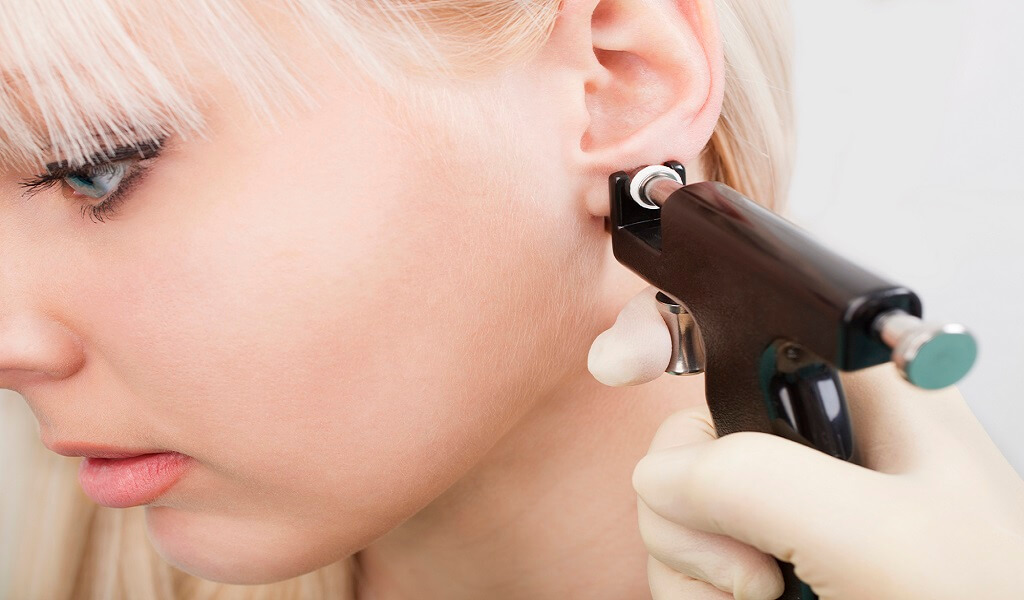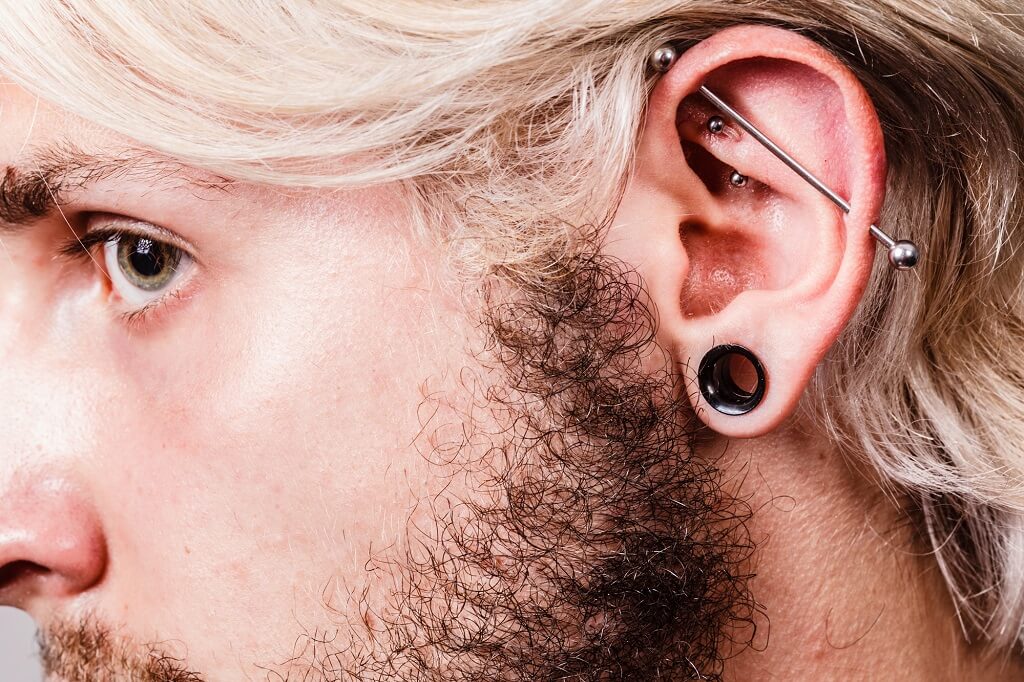If you’ve recently had your ears pierced and have your eyes on a new set of earrings, you may ask ‘how long after a new ear piercing can I change earrings?’
For new ear piercings, it is recommended that you wait between 6 and 8 weeks before you attempt to change earrings. This is because most ear piercings will heal in this amount of time.
This is a rough answer because it depends on which type of piercing you have.
With so many different ear piercings to choose from, it’s important to know when you can and cannot take the earrings out to change them.
If you’re thinking of getting your ears pierced, the following should prove very useful.
Ear piercings and when to change them

If you’re getting your ears pierced, it’s important you don’t remove the earrings before the piercing has fully healed.
Here’s a look at some different ear piercing types and when it’s safe for you to change them.
| Ear Piercing Type | When to Change Ear Piercing |
| Lobe piercing | 6 – 8 Weeks |
| Snug | 4 Months |
| Helix | 3 – 6 Months |
| Conch | 6 – 9 Months |
| Tragus | 8 Weeks |
| Industrial | 5 – 9 Months |
1. Lobe piercing

A lobe piercing, also known as an earlobe piercing, is the most common type of ear piercing.
As the name implies, it is a piercing that goes through the earlobe – the fleshy part of the lower ear.
Earlobe piercings are the easiest type of ear piercing to heal, and also the fastest to heal.
With special care and attention, an earlobe piercing will heal in around 6 – 8 weeks.
You’ll notice that the piercing is tender for the first 2 – 3 days, and slightly swollen, but by the end of the first week, most of the pain and swelling will have gone.
2. Snug piercing
A snug piercing passes through the cartilage on the outer ridge of the ear. It is horizontal and passes through the anti-helix, sitting directly above the anti-tragus.
The average healing time for a snug piercing is 4 months.
Snug piercings take much longer to heal than a standard lobe piercing, which is why you need to leave them alone.
Snug piercings heal best when given time, so resist the urge to play with them
Make sure you keep the piercing clean and avoid sleeping on the ear with the piercing as well.
3. Helix piercing

A helix piercing is one that is located on the upper and outer ear, passing through the cartilage.
Healing times for a helix piercing vary greatly from person to person.
Some people will heal within 3 months, while others will need 6 months before their helix piercing heals fully.
Helix piercings are prone to infection, so keep an eye out for any discharge, painful swelling, or inflammation.
Because they are prone to infection, you must ensure you keep the piercing, and the surrounding area clean and sterile.
4. Conch piercing

Conch piercings get their name from the fact that they are located on the inner or the outer part of the middle ear known as the ‘concha’.
An inner conch piercing requires a hole to be made through the center of the ear to allow for a stud to be inserted.
An outer conch piercing allows for a ring to be located around the outer edge of the cartilage of the ear.
Conch piercings take a long time to fully heal, with 6 – 9 months being the average figure.
As it is a cartilage piercing you need to avoid infection so clean the piercing 2 – 3 times per day with a very mild soap solution, or a sterile saline salt solution.
5. Tragus piercing

A tragus piercing is a piercing of the tragus, which is a thick piece of flesh covering the opening of the ear.
The tragus is there to help protect and cover the tube which leads to internal organs within the ear, such as the eardrum.
Most tragus piercings heal in roughly 8 weeks. Because of the location of the tragus, you’re more likely to touch a tragus piercing with your hands.
This is why you need to clean the piercing 2 -3 times per day and keep your hands clean.
6. Industrial piercing

Industrial piercings are also known as scaffold piercings because they resemble scaffolding found on a construction site.
It is any 2 pierced holes in the ear that are connected via a straight, single piece of jewelry. It’s basically a 2-in-1 piercing.
Industrial piercings require a lot of healing time, taking between 5 and 9 months on average to fully heal.
The first week of the piercing will be the worst in terms of pain. The piercing will be swollen and inflamed, though each day the swelling will subside.
These piercings are the most sporadic in terms of healing. One week it may look and feel fine, whereas the next it might be inflamed and painful.
Because of the size of the piercing, you need to be very careful not to knock it.
How do I know when my ear piercing has healed?
Ear piercings heal at different rates for different people. Some may find that their piercings heal much quicker than others.
There are plenty of things you can look out for that will indicate whether or not your piercing has healed.
You will be able to tell whether or not your piercing has fully healed by examining it.
Once it is no longer sore or tender and is free from discharge, flakiness, swelling, and redness, it will almost certainly be fully healed.
If you notice any of the above, or if it doesn’t feel right, it is probably still healing.
What should a healing piercing look like?

If you’ve recently had your ears pierced, you need to make sure that the piercings are healing correctly.
If an ear piercing is not healing properly, it puts you at risk of infection, and other complications.
A healing piercing should look healthy. You will also probably notice a small amount of dry matter known as ‘exudate’ found on the exit and/or opening of your piercing.
If you do, don’t worry, this is very common and is a good sign as it shows the healing process is going well.
A little redness and swelling is normal. However, if the piercing looks very red and inflamed, this could be a sign that something is wrong.
How can I speed up the healing process of my ear piercing?
After getting a new ear piercing, you may be eager to speed up the healing process so you can play around with it and try different earrings.
You should never remove earrings or mess with a piercing before it has fully healed.
The good news is that there are things you can do to speed up the healing process.
Make sure that any clothing, bedding, or material that will come into contact with your piercing is clean.
The idea here is to minimize germs and bacteria coming into contact with the piercing hole.
You can also consume plenty of vitamins and minerals.
Vitamins, especially vitamin C, and minerals such as zinc help strengthen the immune system and speed up the body’s natural healing abilities.
How long do ear piercings hurt?
The amount of time your new ear piercings hurt will depend on you, your pain tolerance, and the type of piercing you’ve had done.
A couple of days after an ear piercing, it’s normal for it to feel sore and tender, and to be red and swollen.
After the first couple of days, the pain and swelling should subside more and more with each passing day.
If you notice after a couple of weeks, that your piercing is crusty, or is starting to feel sore, tender, or painful again, this could be a sign of infection, so get it checked out.
When can I stop cleaning my ear piercing?

With any piercing, keeping it clean and hygienic is essential if you wish to keep it healthy and free from infection.
Depending on the type of ear piercing that you have, you should use a cleaning solution 3 times per day during the healing process.
That is 6 weeks for a lobe piercing and 12 weeks for a cartilage piercing.
Once your ear piercing has fully healed, you should then use an ear piercing cleaning solution as needed. Once per day should suffice.
How do I know if my piercing is rejecting?
Ear piercings aren’t guaranteed to heal. Sometimes the body rejects the piercing, which is the last thing that you want.
If you’re unsure about whether or not your piercing is being rejected or not, there are things to watch out for.
If the earring is visible outside of the piercing, this is a common sign of rejection.
The piercing may remain sore, inflamed, itchy, and painful weeks later. This is another piercing rejection sign to watch out for.
Finally, if you can see the jewelry under the skin, if the piercing hole is getting bigger, or if the earring feels looser, these are other indications of piercing rejection.
How often should I take my earrings out to clean?
As well as cleaning the piercing site, once fully healed, you should also clean your earrings every so often as well.
If you’re wearing the same set of earrings constantly, you should try to clean them once per week.
If you switch between sets of earrings, you should clean them monthly, or sooner if needed.
People with sensitive ears should clean their earrings more frequently.
Can I change my earrings after 4 weeks?
No, professionals recommend that you do not change your earrings any earlier than 6 weeks after your first piercing, assuming it’s a basic earlobe piercing.
Any sooner, and the piercing wound won’t have had time to fully heal.
Can ear piercings close up overnight?
Yes, if an ear piercing has not fully healed, it can close up in less than a day, sometimes overnight.
This is why it’s so important to leave your earring/stud in until the piercing has had the time to fully heal.
Which ear piercing heals the fastest?
Usually, an earlobe piercing is the most comfortable type of piercing, with the fastest healing time.
Healing rates differ from person to person, but earlobe piercings are nearly always the ones that heal the quickest.

